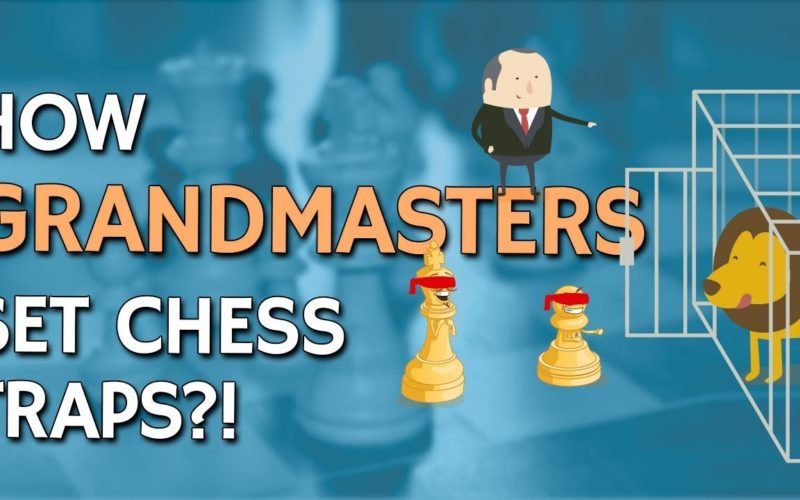♕ Learn More with this special offer: https://www.ichess.net/sale/setting-chess-traps-like-grandmaster/
Every amateur love to set traps to their opponents. What a pleasure when the opponent’s falls in it! But as the knowledge grows, club players tent to rely less and less in the traps. GMs don’t play for traps!
That’s a big misunderstanding. GMs also set traps everywhere, but they are of a different kind.
So, let’s see what IM Valeri Lilov has to teach us about the different kind of traps and how you can ambush your opponents with subtle play.
In the free video, IM Lilov explores in detail the different types of traps, and how to set them, so here we are only going to do a brief summary. Watch the full video to get the complete lecture!
Traps As The Only Goal
What amateurs mostly do it’s to set trap with only aim to catch the opponent. That’s the kind of trap that should be avoided, as they usually only deteriorate your own position.
Let’s look at one of them. After 1.g4? d5 2.Bg2 Bxg4 3.c4 c6 4.cxd5 cxd5 5.Qb3, the following position is reached:How Grandmasters Set Chess Traps 1
White is a pawn down, but now he is attacking both pawns on d5 and b7. What do you think Black should play?
Black must protect the central d5-pawn, as is the more important of the attacked pawns. And Black has only 2 logical ways to do it, named 5…e6 and 5…Nf6.
But the first one is a blunder! After 5…e6?? 6.Qa4+ the Bg4 falls, and White gets a winning position. So, Black must play 5…Nf6. After a possible continuation like 6.Qxb7 Nd7 7.Nc3 e6 Black has a sound position, with a better central control and development, while the Qb7 is exposed. All in all, Black is better!
So, what did White achieve playing this marginal opening? Perhaps he win 2 or 3 games due to the 5…e6 blunder, but on the rest of his games he surely had to suffer for many moves in an inferior position. That’s not advisable for the improving player that want to win more games!
Attacking Traps
Traps can and should be strategically in nature. The previous kind of traps, when you try to confuse your opponents to play a blunder, are easily avoided by Club Players with good tactical skills. But you can set up strategical traps, to lure your opponent into a bad position because he didn’t discover your “secret” plan.
Let’s look at an attacking trap that’s the leitmotif of the Grand Prix Attack against the Sicilian Defense. Suppose your opponent is a Dragon-fan, and he always plays the same opening moves. You can set him a trap by playing the Grand Prix Attack, as against this anti-Sicilian the same scheme can be treacherous. The next position is what White is hoping for: How Grandmasters Set Chess Traps 2
Black has played the classical Dragon moves and now he is under big pressure. White is planning Bh6, Ng5, and the Black’s castle is in real danger (f7 and h7 are really difficult to defend). White can win hundreds of games like this!
What Black should have played? He should have attack in the center preparing the central thrust …d5!
There are two key points of this “opening trap”.
The attacking idea is not obvious before you are in real danger. And then can be really late! You have to foresee lots of moves (or known the idea) to prevent it!
Even if Black makes all the best moves, White is not worse! That’s an important difference between this example and the previous one!
Positional Traps
These are probably the most dangerous kind of traps, as it’s really difficult to avoid falling in them!
In the positional traps, the aim of the trap is not to win material, or create a killing attack. The “only” idea is to win a positional advantage or to lure you into a different type of position, where you will be very uncomfortable.
Let’s look at a typical position in the Sicilian Defense. After 1.e4 c5 2.Nf3 d6 3.d4 cxd4 4.Nxd4 Nf6 we are in the last diagram: How Grandmasters Set Chess Traps 3
Black is ready to answer 5.Nc3 with the Najdorf (5…a6), the Dragon (5…g6) or the Scheveningen (5…e6). But White can be tricky and play 5.f3!?. Most Black players will follow they usual recipe, thinking that after 6.Nc3 it’s just a transposition to the usual lines. But they will have a big disappointment when White plays 6.c4!, creating a Maroczy Bind!
The Maroczy it’s not an instant win. In fact, if Black knows what he is doing, he can reach playable positions. But most Sicilian players don’t know what to do in this pawn structure!
Conclusion
While most amateurs play the first kind of traps, masters are persistently searching for the latter ones, trying to catch their opponents into difficult positions. After all, you can’t win if your opponent doesn’t make any mistake!
If you can learn more about chess traps, click here to check out the course Devastating Opening Traps by IM Valeri Lilov, with an special discount.
♕ 10 GM SECRETS: https://www.ichess.net/10gmsecrets/
♕ MORE:
http://www.facebook.com/iChessNET/ | http://twitter.com/onlinechessless

